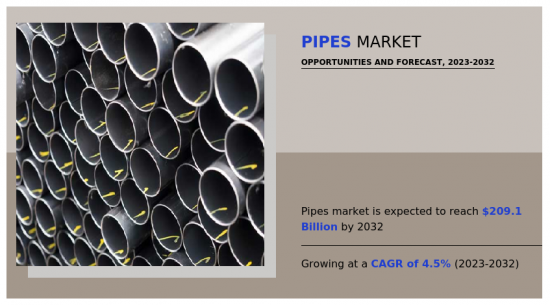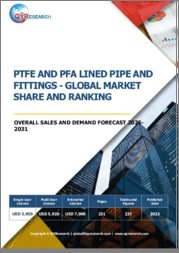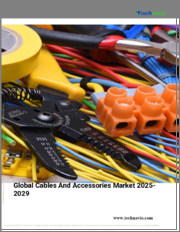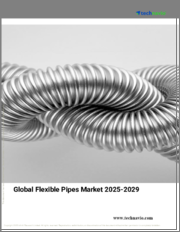
|
시장보고서
상품코드
1344491
세계의 파이프 시장 : 소재별, 직경별, 용도별 - 기회 분석 및 산업 예측(2023-2032년)Pipes Market By Material, By Diameter, By Application : Global Opportunity Analysis and Industry Forecast, 2023-2032 |
||||||
파이프(Pipes) 시장은 2020년에 1,195억 달러로 평가되었고, 2023년부터 2032년에 걸쳐 CAGR 4.5%로 성장하여 2032년에는 2,091억 달러에 달 그렇다고 추정됩니다.
파이프는 액체, 가스, 슬러리를 운반하도록 설계된 속이 빈 원통형 구조물입니다. 플라스틱, 금속, 콘크리트, 복합재 등 다양한 재질로 제공됩니다. 플라스틱 파이프는 일반적으로 폴리염화비닐(PVC), 고밀도 폴리에틸렌(HDPE) 및 기타 복합 플라스틱으로 만들어집니다. 금속 파이프는 스테인리스 스틸, 탄소강, 합금강, 구리, 알루미늄 등의 재료를 사용하여 제작됩니다.

다양한 직경, 모양 및 재질의 파이프는 배관, 하수, 전기 도관 및 HVAC 시스템과 같은 다양한 응용 분야를 위해 건물에 사용됩니다. 따라서 건물 수의 증가는 파이프 시장 성장의 주요 동인입니다. 또한 폐수 처리장, 커뮤니티 워터 펌프, 하수, 가스 파이프 라인, 빗물 배수 시스템 및 기타 다양한 수의 증가도 시장에 긍정적 인 영향을 미치고 있습니다. 또한 화학 물질, 물, 공기, 증기 등을 공급하는 데 파이프가 널리 사용되는 전 세계 산업 부문의 성장도 파이프 시장 성장을 이끄는 주요 요인입니다. 그러나 원자재의 높고 변동하는 비용은 시장 성장의 주요 제약 요인입니다. 또한 복합 재료 기술의 발전과 복합 재료의 제조 공정의 발전은 파이프 시장의 성장에 유리한 기회를 제공 할 것으로 예상됩니다.
또한 우크라이나-러시아 전쟁으로 인한 인플레이션 상승으로 인해 석유 및 가스 가격과 원자재 가격이 전 세계적으로 변동성이 커지고 있습니다. 이로 인해 파이프 시장 및 관련 산업의 성장이 더디게 진행되고 있습니다.
목차
제1장 서론
제2장 주요 요약
제3장 시장 개요
- 시장 정의 및 범위
- 주요 조사 결과
- 영향 요인
- 주요 투자 기회
- Porter's Five Forces 분석
- 시장 역학
- 성장 촉진 요인
- 건축건설 업계의 성장
- 신흥국에서 인프라 정비의 진전
- 제조업의 성장
- 억제 요인
- 원재료 가격 변동
- 기회
- 파이프용 신소재의 개발
- 성장 촉진 요인
- COVID-19에 의한 시장에 대한 영향 분석
제4장 파이프 시장 : 소재별
- 금속
- 열가소성 플라스틱
- 콘크리트
- 열경화성·복합재료
제5장 파이프 시장 : 직경별
- DN 50mm 이하
- DN 51-150 mm
- DN 151-300 mm
- DN 301-500 mm
- DN 501mm 이상
제6장 파이프 시장 : 용도별
- 상하수도
- 산업
- 석유 및 가스
- 기타
제7장 파이프 시장 : 지역별
- 북미
- 미국
- 캐나다
- 멕시코
- 유럽
- 독일
- 프랑스
- 이탈리아
- 영국
- 기타 유럽
- 아시아 태평양
- 중국
- 일본
- 인도
- 한국
- 기타 아시아 태평양
- LAMEA
- 남미
- 중동
- 아프리카
제8장 경쟁 구도
- 소개
- 주요 성공 전략
- 주요 10개사의 제품 매핑
- 경쟁 대시보드
- 경쟁 히트맵
- 주요 기업의 포지셔닝(2020년)
제9장 기업 개요
- ArcelorMittal
- ASTRAL LIMITED
- JM EAGLE, INC.
- Nippon Steel Corporation
- Nucor Corporation(Nucor Tubular Products)
- Sumitomo Corporation
- Tata Steel Limited
- Tenaris SA
- United States Steel Corporation
- Prince Pipes And Fittings Ltd
According to a new report published by Allied Market Research, titled, "Pipes Market," The pipes market was valued at $119.5 billion in 2020, and is estimated to reach $209.1 billion by 2032, growing at a CAGR of 4.5% from 2023 to 2032. Pipes are hollow cylindrical structures, designed to transport liquids, gases, and slurries. They come in various materials, including plastic, metal, concrete, and composites. Plastic pipes are commonly made from Polyvinyl Chloride (PVC), high-density polyethylene (HDPE), and other composite plastics. Metal pipes are constructed using materials such as stainless steel, carbon steel, alloy steel, copper, aluminum, and others.

Pipes of different diameters, shapes, and materials are used in buildings for various applications such as plumbing, sewage, electrical conduits, and HVAC systems. Thus, rise in the number of buildings is a major driver for the growth of the pipes market. Moreover, rise in the number of wastewater treatment plants, community water pumps, sewage, gas pipelines, stormwater drainage systems, and various others are also positively impacting the market. In addition, growth in the industrial sector globally, where pipes are widely used to supply chemicals, water, air, steam, and others, is also a major factor driving the pipes market growth. However, high and fluctuating cost of raw materials are major restraints in the growth of the market. Furthermore, advancements in composite material technology and advancements in the manufacturing process of composite materials are anticipated to provide lucrative opportunities for the growth of the pipes market.
Furthermore, the price of oil & gas and the price of raw materials are experiencing increased volatility globally, due to rise in inflation mainly driven by Ukraine-Russia war. This has led to slow-paced growth of the pipes market and its related industries.
The pipes market is segmented on the basis of material, diameter, application, and region. By material, the market is bifurcated into metal, thermoplastic, concrete, and thermoset & composite. Depending on diameter, the market is categorized into DN up to 50 mm, DN 50 to 150 mm, DN 150 to 300 mm, DN 300 to 500 mm, and DN above 500 mm. Depending on application, it is divided into water & wastewater, industrial, oil & gas, and others. Region-wise, it is analyzed across North America (U.S., Canada, and Mexico), Europe (Germany, France, Italy, UK, and rest of Europe), Asia-Pacific (China, India, Japan, South Korea, and rest of Asia-Pacific), and LAMEA (Latin America, Middle East, and Africa).
Competition Analysis
Key companies profiled in the pipes market report include ASTRAL LIMITED, Prince Pipes And Fittings Ltd, ArcelorMittal, JM EAGLE, INC., Nippon Steel Corporation, Tata Steel Limited, Tenaris SA., United States Steel Corporation, Sumitomo Corporation, and Nucor Corporation (Nucor Tubular Products). The major players that operate in the global market have adopted key strategies such as acquisition, business expansion, product launch, and other strategies to strengthen their market outreach and sustain the stiff competition in the market.
Key benefits for stakeholders
- The report provides an extensive analysis of the current and emerging pipes market trends, and historic data.
- In-depth pipes market analysis is conducted by constructing market estimations for key market segments between 2020 and 2032.
- Extensive analysis of the pipes market is conducted by following key product positioning and monitoring of top competitors within the market framework.
- A comprehensive analysis of all the regions is provided to determine the prevailing opportunities.
- The pipes market revenue and volume forecast analysis from 2023 to 2032 is included in the report.
- The key players within the pipes market are profiled in this report and their strategies are analyzed thoroughly, which helps understand the competitive outlook of the pipes industry.
Key Market Segments
By Material
- Concrete
- Thermoset and composite
- Metal
- Thermoplastic
By Diameter
- DN upto 50 mm
- DN 51 to 150 mm
- DN 151 to 300 mm
- DN 301 to 500 mm
- DN above 501 mm
By Application
- Water and wastewater
- Industrial
- Oil and gas
- Other
By Region
- North America
- U.S.
- Canada
- Mexico
- Europe
- Germany
- France
- Italy
- UK
- Rest of Europe
- Asia-Pacific
- China
- Japan
- India
- South Korea
- Rest of Asia-Pacific
- LAMEA
- Latin America
- Middle East
- Africa
Key Market Players:
- ArcelorMittal
- ASTRAL LIMITED
- JM EAGLE, INC.
- Nippon Steel Corporation
- Nucor Corporation (Nucor Tubular Products)
- Prince Pipes And Fittings Ltd
- Sumitomo Corporation
- Tata Steel Limited
- Tenaris S.A.
- United States Steel Corporation
TABLE OF CONTENTS
CHAPTER 1: INTRODUCTION
- 1.1. Report description
- 1.2. Key market segments
- 1.3. Key benefits to the stakeholders
- 1.4. Research Methodology
- 1.4.1. Primary research
- 1.4.2. Secondary research
- 1.4.3. Analyst tools and models
CHAPTER 2: EXECUTIVE SUMMARY
- 2.1. CXO Perspective
CHAPTER 3: MARKET OVERVIEW
- 3.1. Market definition and scope
- 3.2. Key findings
- 3.2.1. Top impacting factors
- 3.2.2. Top investment pockets
- 3.3. Porter's five forces analysis
- 3.3.1. Low bargaining power of suppliers
- 3.3.2. Low threat of new entrants
- 3.3.3. Low threat of substitutes
- 3.3.4. Low intensity of rivalry
- 3.3.5. Low bargaining power of buyers
- 3.4. Market dynamics
- 3.4.1. Drivers
- 3.4.1.1. Growth of the building construction industry
- 3.4.1.2. Rise in infrastructural development in emerging economies
- 3.4.1.3. Growth of manufacturing industry
- 3.4.1. Drivers
- 3.4.2. Restraints
- 3.4.2.1. Fluctuating prices of raw materials
- 3.4.3. Opportunities
- 3.4.3.1. Development of new material for pipes
- 3.5. COVID-19 Impact Analysis on the market
CHAPTER 4: PIPES MARKET, BY MATERIAL
- 4.1. Overview
- 4.1.1. Market size and forecast
- 4.2. Metal
- 4.2.1. Key market trends, growth factors and opportunities
- 4.2.2. Market size and forecast, by region
- 4.2.3. Market share analysis by country
- 4.3. Thermoplastic
- 4.3.1. Key market trends, growth factors and opportunities
- 4.3.2. Market size and forecast, by region
- 4.3.3. Market share analysis by country
- 4.4. Concrete
- 4.4.1. Key market trends, growth factors and opportunities
- 4.4.2. Market size and forecast, by region
- 4.4.3. Market share analysis by country
- 4.5. Thermoset and composite
- 4.5.1. Key market trends, growth factors and opportunities
- 4.5.2. Market size and forecast, by region
- 4.5.3. Market share analysis by country
CHAPTER 5: PIPES MARKET, BY DIAMETER
- 5.1. Overview
- 5.1.1. Market size and forecast
- 5.2. DN upto 50 mm
- 5.2.1. Key market trends, growth factors and opportunities
- 5.2.2. Market size and forecast, by region
- 5.2.3. Market share analysis by country
- 5.3. DN 51 to 150 mm
- 5.3.1. Key market trends, growth factors and opportunities
- 5.3.2. Market size and forecast, by region
- 5.3.3. Market share analysis by country
- 5.4. DN 151 to 300 mm
- 5.4.1. Key market trends, growth factors and opportunities
- 5.4.2. Market size and forecast, by region
- 5.4.3. Market share analysis by country
- 5.5. DN 301 to 500 mm
- 5.5.1. Key market trends, growth factors and opportunities
- 5.5.2. Market size and forecast, by region
- 5.5.3. Market share analysis by country
- 5.6. DN above 501 mm
- 5.6.1. Key market trends, growth factors and opportunities
- 5.6.2. Market size and forecast, by region
- 5.6.3. Market share analysis by country
CHAPTER 6: PIPES MARKET, BY APPLICATION
- 6.1. Overview
- 6.1.1. Market size and forecast
- 6.2. Water and wastewater
- 6.2.1. Key market trends, growth factors and opportunities
- 6.2.2. Market size and forecast, by region
- 6.2.3. Market share analysis by country
- 6.3. Industrial
- 6.3.1. Key market trends, growth factors and opportunities
- 6.3.2. Market size and forecast, by region
- 6.3.3. Market share analysis by country
- 6.4. Oil and gas
- 6.4.1. Key market trends, growth factors and opportunities
- 6.4.2. Market size and forecast, by region
- 6.4.3. Market share analysis by country
- 6.5. Other
- 6.5.1. Key market trends, growth factors and opportunities
- 6.5.2. Market size and forecast, by region
- 6.5.3. Market share analysis by country
CHAPTER 7: PIPES MARKET, BY REGION
- 7.1. Overview
- 7.1.1. Market size and forecast By Region
- 7.2. North America
- 7.2.1. Key trends and opportunities
- 7.2.2. Market size and forecast, by Material
- 7.2.3. Market size and forecast, by Diameter
- 7.2.4. Market size and forecast, by Application
- 7.2.5. Market size and forecast, by country
- 7.2.5.1. U.S.
- 7.2.5.1.1. Key market trends, growth factors and opportunities
- 7.2.5.1.2. Market size and forecast, by Material
- 7.2.5.1.3. Market size and forecast, by Diameter
- 7.2.5.1.4. Market size and forecast, by Application
- 7.2.5.2. Canada
- 7.2.5.2.1. Key market trends, growth factors and opportunities
- 7.2.5.2.2. Market size and forecast, by Material
- 7.2.5.2.3. Market size and forecast, by Diameter
- 7.2.5.2.4. Market size and forecast, by Application
- 7.2.5.3. Mexico
- 7.2.5.3.1. Key market trends, growth factors and opportunities
- 7.2.5.3.2. Market size and forecast, by Material
- 7.2.5.3.3. Market size and forecast, by Diameter
- 7.2.5.3.4. Market size and forecast, by Application
- 7.3. Europe
- 7.3.1. Key trends and opportunities
- 7.3.2. Market size and forecast, by Material
- 7.3.3. Market size and forecast, by Diameter
- 7.3.4. Market size and forecast, by Application
- 7.3.5. Market size and forecast, by country
- 7.3.5.1. Germany
- 7.3.5.1.1. Key market trends, growth factors and opportunities
- 7.3.5.1.2. Market size and forecast, by Material
- 7.3.5.1.3. Market size and forecast, by Diameter
- 7.3.5.1.4. Market size and forecast, by Application
- 7.3.5.2. France
- 7.3.5.2.1. Key market trends, growth factors and opportunities
- 7.3.5.2.2. Market size and forecast, by Material
- 7.3.5.2.3. Market size and forecast, by Diameter
- 7.3.5.2.4. Market size and forecast, by Application
- 7.3.5.3. Italy
- 7.3.5.3.1. Key market trends, growth factors and opportunities
- 7.3.5.3.2. Market size and forecast, by Material
- 7.3.5.3.3. Market size and forecast, by Diameter
- 7.3.5.3.4. Market size and forecast, by Application
- 7.3.5.4. UK
- 7.3.5.4.1. Key market trends, growth factors and opportunities
- 7.3.5.4.2. Market size and forecast, by Material
- 7.3.5.4.3. Market size and forecast, by Diameter
- 7.3.5.4.4. Market size and forecast, by Application
- 7.3.5.5. Rest of Europe
- 7.3.5.5.1. Key market trends, growth factors and opportunities
- 7.3.5.5.2. Market size and forecast, by Material
- 7.3.5.5.3. Market size and forecast, by Diameter
- 7.3.5.5.4. Market size and forecast, by Application
- 7.4. Asia-Pacific
- 7.4.1. Key trends and opportunities
- 7.4.2. Market size and forecast, by Material
- 7.4.3. Market size and forecast, by Diameter
- 7.4.4. Market size and forecast, by Application
- 7.4.5. Market size and forecast, by country
- 7.4.5.1. China
- 7.4.5.1.1. Key market trends, growth factors and opportunities
- 7.4.5.1.2. Market size and forecast, by Material
- 7.4.5.1.3. Market size and forecast, by Diameter
- 7.4.5.1.4. Market size and forecast, by Application
- 7.4.5.2. Japan
- 7.4.5.2.1. Key market trends, growth factors and opportunities
- 7.4.5.2.2. Market size and forecast, by Material
- 7.4.5.2.3. Market size and forecast, by Diameter
- 7.4.5.2.4. Market size and forecast, by Application
- 7.4.5.3. India
- 7.4.5.3.1. Key market trends, growth factors and opportunities
- 7.4.5.3.2. Market size and forecast, by Material
- 7.4.5.3.3. Market size and forecast, by Diameter
- 7.4.5.3.4. Market size and forecast, by Application
- 7.4.5.4. South Korea
- 7.4.5.4.1. Key market trends, growth factors and opportunities
- 7.4.5.4.2. Market size and forecast, by Material
- 7.4.5.4.3. Market size and forecast, by Diameter
- 7.4.5.4.4. Market size and forecast, by Application
- 7.4.5.5. Rest of Asia-Pacific
- 7.4.5.5.1. Key market trends, growth factors and opportunities
- 7.4.5.5.2. Market size and forecast, by Material
- 7.4.5.5.3. Market size and forecast, by Diameter
- 7.4.5.5.4. Market size and forecast, by Application
- 7.5. LAMEA
- 7.5.1. Key trends and opportunities
- 7.5.2. Market size and forecast, by Material
- 7.5.3. Market size and forecast, by Diameter
- 7.5.4. Market size and forecast, by Application
- 7.5.5. Market size and forecast, by country
- 7.5.5.1. Latin America
- 7.5.5.1.1. Key market trends, growth factors and opportunities
- 7.5.5.1.2. Market size and forecast, by Material
- 7.5.5.1.3. Market size and forecast, by Diameter
- 7.5.5.1.4. Market size and forecast, by Application
- 7.5.5.2. Middle East
- 7.5.5.2.1. Key market trends, growth factors and opportunities
- 7.5.5.2.2. Market size and forecast, by Material
- 7.5.5.2.3. Market size and forecast, by Diameter
- 7.5.5.2.4. Market size and forecast, by Application
- 7.5.5.3. Africa
- 7.5.5.3.1. Key market trends, growth factors and opportunities
- 7.5.5.3.2. Market size and forecast, by Material
- 7.5.5.3.3. Market size and forecast, by Diameter
- 7.5.5.3.4. Market size and forecast, by Application
CHAPTER 8: COMPETITIVE LANDSCAPE
- 8.1. Introduction
- 8.2. Top winning strategies
- 8.3. Product Mapping of Top 10 Player
- 8.4. Competitive Dashboard
- 8.5. Competitive Heatmap
- 8.6. Top player positioning, 2020
CHAPTER 9: COMPANY PROFILES
- 9.1. ArcelorMittal
- 9.1.1. Company overview
- 9.1.2. Key Executives
- 9.1.3. Company snapshot
- 9.1.4. Operating business segments
- 9.1.5. Product portfolio
- 9.1.6. Business performance
- 9.1.7. Key strategic moves and developments
- 9.2. ASTRAL LIMITED
- 9.2.1. Company overview
- 9.2.2. Key Executives
- 9.2.3. Company snapshot
- 9.2.4. Operating business segments
- 9.2.5. Product portfolio
- 9.2.6. Business performance
- 9.3. JM EAGLE, INC.
- 9.3.1. Company overview
- 9.3.2. Key Executives
- 9.3.3. Company snapshot
- 9.3.4. Operating business segments
- 9.3.5. Product portfolio
- 9.4. Nippon Steel Corporation
- 9.4.1. Company overview
- 9.4.2. Key Executives
- 9.4.3. Company snapshot
- 9.4.4. Operating business segments
- 9.4.5. Product portfolio
- 9.4.6. Business performance
- 9.5. Nucor Corporation (Nucor Tubular Products)
- 9.5.1. Company overview
- 9.5.2. Key Executives
- 9.5.3. Company snapshot
- 9.5.4. Operating business segments
- 9.5.5. Product portfolio
- 9.5.6. Business performance
- 9.5.7. Key strategic moves and developments
- 9.6. Sumitomo Corporation
- 9.6.1. Company overview
- 9.6.2. Key Executives
- 9.6.3. Company snapshot
- 9.6.4. Operating business segments
- 9.6.5. Product portfolio
- 9.6.6. Business performance
- 9.6.7. Key strategic moves and developments
- 9.7. Tata Steel Limited
- 9.7.1. Company overview
- 9.7.2. Key Executives
- 9.7.3. Company snapshot
- 9.7.4. Operating business segments
- 9.7.5. Product portfolio
- 9.7.6. Business performance
- 9.7.7. Key strategic moves and developments
- 9.8. Tenaris S.A.
- 9.8.1. Company overview
- 9.8.2. Key Executives
- 9.8.3. Company snapshot
- 9.8.4. Operating business segments
- 9.8.5. Product portfolio
- 9.8.6. Business performance
- 9.8.7. Key strategic moves and developments
- 9.9. United States Steel Corporation
- 9.9.1. Company overview
- 9.9.2. Key Executives
- 9.9.3. Company snapshot
- 9.9.4. Operating business segments
- 9.9.5. Product portfolio
- 9.9.6. Business performance
- 9.10. Prince Pipes And Fittings Ltd
- 9.10.1. Company overview
- 9.10.2. Key Executives
- 9.10.3. Company snapshot
- 9.10.4. Operating business segments
- 9.10.5. Product portfolio
- 9.10.6. Business performance
- 9.10.7. Key strategic moves and developments



















